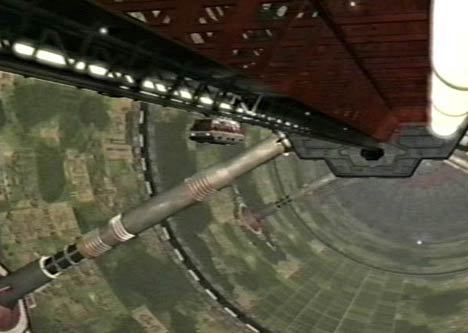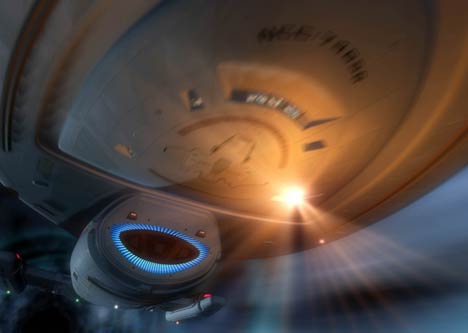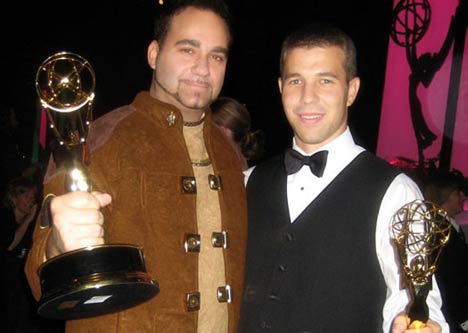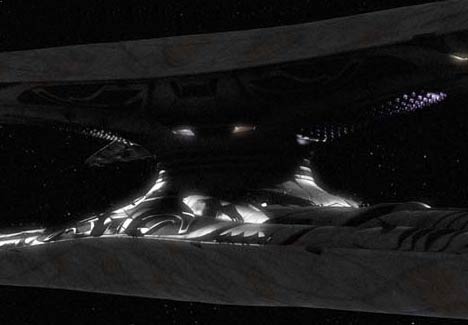Interview with “Mojo,” a Visual Effects Supervisor and artist who has worked on projects such as Battlestar Galactica, Star Trek: Voyager, and Babylon 5 — ed, N.E. Lilly
Interview with “Mojo”
“Mojo” currently acts as a Visual Effects Artist & Sequence Designer for the re-imagined Battlestar Galactica. His career began in 1992 on the series Babylon 5 with Foundation Imaging. He served as a CG Supervisor for Star Trek: Voyager and as Visual Effects Supervisor for the Las Vegas attraction “Borg Invasion.” Other credits on genre shows and movies include Serenity and the re-mastered version of Star Trek: The Motion Picture. He won an Emmy Award for his work on the Voyager episode “Dark Frontier“ and for his work on Battlestar Galactica.
You can discover even more about “Mojo” and his work at darthmojo.wordpress.com/.
How did you get involved in creating Computer Generated Imagery?
I taught myself the basics and was hired onto Babylon 5 while I was still a novice. Working full time as a 3D artist will teach you a LOT very quickly! I often suggest people skip computer graphics school, as all the hardware you need is sitting on your desk at home. The internet provides many learning tools, such as forums and tutorials… school can be good because of the discipline and forced learning environment, so if you’re lazy maybe you would benefit from that sort of “boot camp.” On the other hand, I highly recommend people take film-related classes, such as photography, editing and film theory. After all, 3D animation really is making a little movie in your computer, so have a film-making skill set makes sense. I can tell you now, those Emmy Awards sitting on my shelf are not the result of being a good computer animator — than to my education as a film maker.
How did you get involved with the Science Fiction genre?
Sitting and watching Star Trek with my dad when I was young. Then Star Wars came out and that was that.
What was your first introduction to Space Westerns?
I didn’t know that space westerns were an entire genre. I mean you’ve got Ice Pirates, Spacehunter and Firefly/Serenity. What else is there?
How do you define “Space Western”?
I define it as a western, but set in space.
The special effects for Babylon 5 were ground-breaking for the time and ushered in the transition from traditional spaceship models to CGI spaceships. What was it like to be working on the show at that time?
When doing the pilot for B5 we were very much aware that we were doing something that had never been tried. We had no books, tutorials or user forums to go to for help (in fact the WWW hadn’t even sprung up yet). It was exciting, and then for the pilot to win an Emmy and get all this coverage because of the effects was very gratifying. I don’t think JMS was too thrilled though — he wanted people to focus on the writing! But hey, I know there were a lot of people who tuned in at first because of the effects, but were eventually hooked because it was a great show. Anything that brings you an audience should be embraced!

Given that Babylon 5 was a completely new series, where was the inspiration taken from for the various ship models?
Ron Thornton and Steve Burg did most of the design work and they both have excellent asthetics. A lot of designs were inspired by nature, such as spiders (the Shadow ship), angelfish (the Minbari cruiser) and a bulb of garlic (the Vorlon ship)! Especially for an organic design, I think it works best to start with a basis that people will find subconsciously familiar. Besides, trying to design totally from scratch is a pain in the ass.
Star Trek: Voyager was the first incarnation of a Star Trek show to use CGI exclusively for its ship models. What did it take to convince people that the space scenes could be done in full CGI?
Actually Voyager started off with both traditional miniature and CG work. Obviously Babylon 5 showed them it could be done, so it just took a few episodes of “all-CG” for them to eventually come around. I think the creature we did in “Basics” showed them how CG could deliver shots they would never have had the money for using traditional means. It took them a while to get comfortable with it and for the writers to realize they could put more imagination and “scale” in the shows. Honestly, I think “Scorpion” was the first time they rolled their sleeves up and just decided to have some fun with their new toy!
However, the Star Trek: Deep Space 9 episode “Sacrifice of Angels” was quite literally the turning point in the Star Trek franchise — starting with that episode, the line was drawn in the sand and the visual effects teams were told “no more models.”

How do you feel about the remastering of the special effects for the original Star Trek?
As with any project, it has both highlights and less-than-stellar moments. CBS really should have given them more time.
What do you think about a similar project for Babylon 5?
Babylon 5 simply does not the legacy and widespread audience to make a project like this economically feasible. I’m not sure they could sell enough hi-def DVDs to make up the cost, and since most of the models and original scene files are lost, it would be like starting from scratch.
Remember, Star Trek TOS was not an effects-heavy show, so there really wasn’t an overflow of material; I remember “Severed Dreams” had more than five full minutes of visual effects, probably more than ten episodes of Trek. That being said, I’d love it if someone like Bill Gates liked B5 enough to just fund the project as a tax write off.
How big of a Battlestar Galactica fan are you?
The biggest. Everyone knows that!
How much inspiration did you take from Firefly for working on the various models and scenes on Battlestar Galactica?
Absolutely none. You could argue that the hand-held style of visual effects in Firefly inspired Galactica, but the truth is 100 years of handheld cinema had been there already. Ron Moore wanted Galactica to be documentary-style, so regardless of Firefly, we would have done the shots the same way.
What was it like, being in a show-down with an L.A. cop while in full Battlestar Galactica Colonial garb?
To be honest, I was expecting at some point in the evening someone would have a problem with the laser pistol; I just expected it from security inside the Shrine, not a cop in the street! However, I’m glad it happened, because I got a great story out of it.

Stylistically, what are the key differences in working with Battlestar Galactica, Star Trek: Voyager, and Babylon 5?
Star Trek and B5 were very much a traditional approach, so despite the art direction, the style of FX on those shows were similar. Since Galactica is hand-held, it’s a very different style. The zoom alone allows you to create long shots that would have normally been two or three — the lack of constant editing helps make the viewer believe they’re watching something real. However, the BIGGEST difference is in the creative freedom we had on B5 and Galactica — both JMS and Ron Moore have pretty much taken off the restraints and let us do what we do best — be a buch of crazy, creative nerds. The stuff these shows have gotten has been so much more interesting and dynamic than anything we could do on Star Trek, since Trek was so steeped in tradition a lot of rules had to be followed. Still, all of these shows have their own style and that’s part of what makes them enjoyable and unique.
What are your favorite memories from working on Battlestar Galactica, Star Trek: Voyager, or Babylon 5?
B5 was “Severed Dreams,” Galactica was “Exodus, Pt 2” and Trek was probably “Scorpion.” They were all shows that challenged us creatively and technically, but what I think they all have in common is they are standout episodes, PERIOD. Great drama + great action = home run. These shows got us excited because they were great scripts and when a great script comes in you find that all the departments go the extra mile. You have no idea how rare it is in Hollywood to sit back in a darkened room and feel an overwhelming sense of pride to have contributed to such a fine product. Before Galactica, B5 was the last time it had happened and after Galactica, who knows. We had a screening of “Revelations,” the BSG 4th mid-season finale in Hollywood, which received incredible accolades from fans and the press. Duirng the party afterwards, we (not just the FX team, but the writers, producers, editors, everyone) were all so jazzed and happy about the buzz over the show. At one point writer/producer Bradley Thompson came up to me and said “savor these moments” and he is absolutely right — you never know when the next one is going to be. I feel very lucky.
Is there any one scene that you’ve worked on that you’re particularly fond of?
That’s a tough one… maybe the shot in “Exodus, Part II” when Adama says goodbye to the crew and the camera pulls out… we see the Galactica being pounded by baseships and we get further and further away and the music swells up and as a member of the audience you REALLY BELIEVE that this it it, they might all die… and then the Pegasus comes in, guns a-blazing and saves the day! That was a shot I had been working on for a while and had done several (very different) versions of it that the producers kept sending back, feeling it still wasn’t hitting the mark. Then I took a look at the scene of Adama and the C&C crew and sucked in all the emotion of it and BAM, I had a sudden inspiration of what that shot should be — I saw the whole thing in my head, music, sound effects and all. I discussed it with effects supervisor Gary Hutzel and he basically said “go for it!” I even hand-delivered the previz to the editor and we sat together to pick the right music and make it all gel. I remember about a half hour later we watched what we had done and we both hit the roof, we knew we had nailed it. Gary sent it off to Ron and David and the emailed response was one word: BRAVO. It was perhaps the most gratifying moment of my career, not because I had done a cool shot, but because my superiors believed in me, they “got it” and I had actually had a hand in making the show more dramatic and rewarding for the audience. Everyone on BSG “gets it” and that’s what makes it not only a pleasure to watch but a pleasure to work on.
Savor these moments, indeed.
What has been the most challenging CGI effect that you’ve had to create?
Honestly, the biggest challenge is getting everything done on time! The sharpest double-edge sword on Galactica is that darned creative freedom we have. We’ll often get overenthusiastic and take a 3 shot sequence and turn it into 10 shots because we think it will play better… but now we have to do 10 shots in the time alotted for 3! But we love the work and the show so we do it. But as for individual shots… I don’t know, it’s hard to say which ones were the hardest work when it doesn’t feel like work! The shot in “Razor” of the old-school Cylon Raider slamming into the landing bay gangway was a bitch… that also wasn’t scripted, the Raider was simply meant to smash into the floor… but when I started designing the shot and playing around in the landing bay, I saw that giant gangway… and couldn’t resist. I almost didn’t do it because I knew it would be so much extra work to animate all that debris, but once I saw it in my head I couldn’t turn my back on it. I didn’t do the final effects work in that shot, that was Sean Jackson, our pyromaster, but the previz shot I did was so detailed we were able to keep most of it for the final animation.
Do you have any advice for someone new to creating Computer Generated Imagery and digital special effects?
Yes, study film making, not computers.
What do you think the attraction is to Space Westerns?
I think the attraction is that there are so few of them!
Can you let me in on any exclusive information, unknown insights, or trade secrets?
Yes, there is a hidden mechanical Daggit buried in one of the FX shots in one of the first 10 episodes of this season. Freeze-frame fanatics, start your engines!
What else can we expect to see from you in the near future?
More cool stuff on Galactica! Maybe even another hidden Daggit. Actually, it’s funny, when we were working on B5 and Star Trek I’d try and sneak in Galactica references wherever I could, and now that I work on Galactica, I’m STILL sneaking in Galactica references!

♠
Other works by N.E. Lilly
- Is Firefly “Out of Gas”? (Dec 12, 2022)
- The Emancipation of Bat Durston, or, “I’m from Iowa, I only work in Outer-space” (Dec 5, 2022)
- Interview with Phil Foglio (Nov 8, 2009)
- 10 Most Influential Space Westerns (Oct 25, 2009)
- Space Western Most Wanted (Jan 25, 2009)
- more by N.E. Lilly
Related articles
- 10 Most Influential Space Westerns by N.E. Lilly (Oct 25, 2009)
- Space Western Most Wanted by N.E. Lilly (Jan 25, 2009)
- Battlestar Galactica Role-Playing Game Review by Kenneth J. Newquist (Jul 27, 2008)
- Interview with Seamus Kevin Fahey by N.E. Lilly (May 18, 2008)
- The Battlestar Galactica Code: The Last Cylon by N.E. Lilly (Apr 22, 2008)
- Interview with David Weddle by N.E. Lilly (Apr 20, 2008)
- Behind the Scenes of Star Trek: Of Gods and Men by N.E. Lilly (Jan 20, 2008)
- Space Western Holiday Specials by N.E. Lilly (Dec 16, 2007)
- Interview with Jane Espenson by N.E. Lilly (Dec 9, 2007)

I Love Serenity
Men’s Basic T-Shirt that says “I Love Serenity” in Chinese.
Available from the Space Westerns Magazine Store on Zazzle →

Comments
You are not logged in. Log-in to leave a comment.